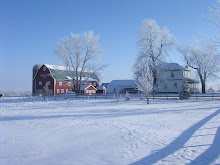Bright and early we met in the creamery to go over the rules. We put on white coats, wore foot covers and, best of all, put on our hair nets. Since I have always had a beard since I was four (very macho) I got to wear a beard net as well. Now this was as stylish as I have ever been. We went through the different pieces of equipment and discussed where you spend the major percentage of your time in a cheese making operation...cleaning. Everything must be kept meticulously clean to avoid contaminating the milk, whey or cheese with "bad" bacteria. The use of hot water and chlorine bleach is constant. Some of the rules of cheese making in the UK are a bit different then in the US. Back home any cheese that is not going to be aged for at least 60 days must be made from pasteurised (note the "s" instead of a "z", very European) milk. We got to choose which cheese we wanted to make and I went for Double Gloucester which I would age for a few months so I could make what is called a "raw" milk cheese. To start we had the opportunity to help make crowdie, which is a traditional Scottish cheese generally used as an ingredient and yogurt which they sell retail and to chefs. Since these are both "fresh" products they would have to be made with pasteurized milk which was run through their HTST (High Temperature, Short Time) pasteuriser. This unit brings the milk up to 161 degrees Fahrenheit by blasting it through a radiator type device with hot water on one side and holds it there for 15 seconds. In our operation we are planning to use a gentler method called "vat" pasteurization. With the vat method we slowly bring the milk to 145 degrees F and hold it for 30 minutes while continuously and gently stirring it. There are several reasons that I want to use this method which we will go over later. The crowdie is an interesting product. The curd is wrapped in cheese cloth and allowed to drain over a bucket for many hours before it is scraped off of the cloth and packaged. Yogurt is made with faith as you inoculate it with a culture and then put into a warmed incubation room to grow. They actually make it in the shipping containers and just assumed that it worked and that we had thick yogurt when we were done. I was not so confident and had to look. Oh ye of little faith. It seemed amazing to me, there was yogurt where once there had been warm milk. With the preliminaries out of the way, the basic procedures reviewed, a little practice on other products and a short discussion on Fahrenheit vs Celsius temperature scales we are ready to move on to our main project. Most of the recipes that we were using had been marked in both Fahrenheit and Celsius or Centigrade which is what is now used in most of the world except the US. We think that 32 degrees is freezing for (fresh) water and 212 degrees is boiling as we use the Fahrenheit scale always abbreviated with a capital "F". The Celsius scale ("C") is much simpler using zero as freezing and 100 degrees as boiling. Someday we'll catch up. Making a hard cheese is the main reason I am here although the other products are very interesting and I want to continue to learn about them and a myriad of other products for our creamery.
Now let's take a look at the main event, real cheese.
Subscribe to:
Post Comments (Atom)

Where's the cheese?
ReplyDelete